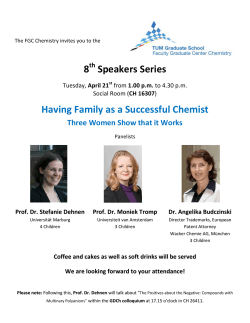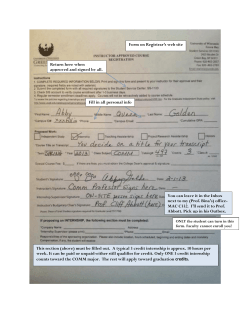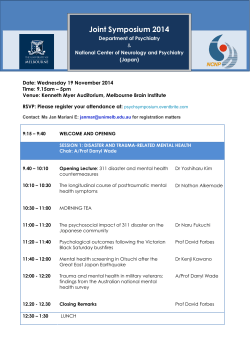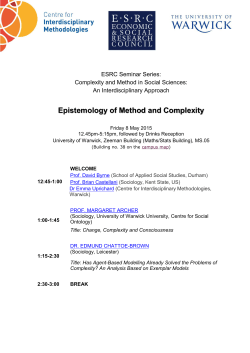
EXECUTIVE SUMMARY 1ST PROJECT PERIOD
EXECUTIVE SUMMARY 1ST PROJECT PERIOD Non-coding RNAs in neurogenic and Neuropathic pain mechanisms and their application for risk assessment, patient stratification and personalised pain medicine Period covered: 01/10/2013 to 31/03/2015 Coordinator: Prof. Dr. Michaela Kress, Medical University Innsbruck Contact: michaela.kress@i-med.ac.at The ncRNAPain project has received funding from the European Union’s Seventh Framework Programme for research, technological development and demonstration under grant agreement n° 602133. CONTEXT & OBJECTIVES Neuropathic pain syndromes are characterized by persistent and severe pain after nerve damage, trauma or surgery. Ample evidence suggests that neuro-immune alterations in the peripheral and central nervous system play a role in the pathophysiology of neuropathic pain. Non-coding RNAs (ncRNA) including microRNAs target transcriptional or other regulatory genes modulating both immune and neuronal processes including cognition through direct or indirect alterations of neuron–glia and/or brain-to-body signalling. ncRNAPain has brought together a multidisciplinary consortium of clinical partners, epidemiologists, neuroscientists, bioinformatics and ncRNA experts to investigate ncRNAs specifically in neurogenic and neuropathic pain with the aim to identify and validate pain predisposing ncRNA patterns and polymorphisms as biomarkers for pain and as druggable molecular targets for pain prevention and pain relief. The project furthermore aims to understand ncRNA regulation of circuitries and processes modulating nociception and endogenous analgesia as well as the role of ncRNAs in the cognitive, emotional and behavioural components of pain in the first reporting period of the work plan. PARTNERS Prof Michaela Kress, Prof Alexander Hüttenhofer, Prof Florian Kronenberg, Prof Zlatko Trajanoski (Innsbruck Medical University); Prof Claudia Sommer, Prof Heike Rittner (University Hospital of Würzburg); Prof Frank Birklein (University Medical Center of the Johannes Gutenberg University Mainz); Prof Rohini Kuner (Heidelberg University Hospital); Prof Marzia Malcangio (King’s College London); Prof Josef Bednarik (CEITEC Masaryk University Brno – University Hospital); Prof Marc Landry (University of Bordeaux); Peter Mouritzen (EXIQON A/S); Prof Hermona Soreq (The Hebrew University of Jerusalem); Dr Paul Heppenstall (The European Molecular Biology Laboratory); Dr Vera Schneider (European Research and Project Office GmbH) 28/05/2015 2 FIRST SCIENTIFIC RESULTS Small cohorts of well-characterised patients with defined pain disorders (diabetic neuropathy with or without pain, CRPS, nerve lesion) and healthy controls were recruited to perform RNA-seq for identification of differentially expressed ncRNAs/miRs. These activities were complemented by the screening and identification of differentially expressed ncRNAs/miRNAs in preclinical mouse models followed by validation of expression analysis of ncRNAs in models of neuropathic and neurogenic pain. For this purpose, SOPs and algorithms for bioinformatics analysis of target genes of ncRNAs had to be set-up. ncNRAPain clinical partners collected bio-samples from clinically well-characterized groups of patients and matched controls, filled-in the SOPs and stored and shipped material to analyst partners for isolating ncRNAs. Isolation was highly efficient and a first set of ncRNAs from patients and controls could be identified and bio-statistically analyzed with exciting results. An electronic platform for data exchange was established and recruitment of homogenous patient cohorts for large-scale validation was started. Total RNA isolation and miRNA expression profiling using miRNA expression arrays have been performed in a preclinical model in order to achieve stable expression profiles for different models and the set time points. Initial data analyses have been completed and technical and biological validation of miRNA expression profiling data is currently in progress. Because preliminary results revealed possible problems with snoRNA55 as endogenous control, procedures were standardised to identify suitable endogenous controls for future Taqman-qPCR. Experimental work was initiated to understand the role of pain-related ncRNAs in the pathogenesis of dysfunction of components in the pain pathway and to understand the role of ncRNAs in regulating synaptic circuits. in vitro validation of inhibitors and LNA™ gapmers for knockdown of miRs/ncRNA, including long noncoding RNA has been performed. Reverse genetics with antisense inhibitors is one of the most powerful ways of understanding miRNA or other noncoding RNA function. LNA™ technology has played a pivotal role in development of inhibitors and LNA™ gapmers that are truly unique in terms of potency, specificity and stability. Easy delivery of these molecules into the cells both in vitro and in vivo is considered a great advantage; therefore, the possibility of using the miR inhibitors in vitro without the use of transfection reagent has been explored. Technologies were set-up to identify ncRNA regulators of specific cognitive and emotional components of pain behaviour associated with neuropathic or neurogenic pain. A database was developed with experimentally validated miRNA targets from the literature supplemented with miRNA predictions using state of the art miRNA prediction tools. The database is being maintained with regular literature searches to update with new validated miRNA-mRNA interactions. 28/05/2015 3 EXPECTED FINAL RESULTS AND IMPACTS ncRNAPain will identify and validate pain predisposing ncRNA patterns and polymorphisms as biomarkers for pain and as druggable molecular targets for pain prevention and pain relief. Innovative tools will be developed to enable better patient stratification, for mechanism-based treatment selection and targeted prevention strategies for high risk individuals. ncRNAPain will assess the role of ncRNA regulation of circuitries and processes modulating nociception and endogenous analgesia. Furthermore, the importance of ncRNAs in the cognitive, emotional and behavioural components of pain will be assessed. Manipulating ncRNAs offers the possibility to control multiple targets including immune contributions, sensory processing and cognitive pathways. Based on recent developments it can be expected that ncRNAs and ncRNA derivatives will have fewer sequence-specific “off-target” effects than current drugs. Therefore, ncRNAs are expected to have superior advantages by targeting multiple pain-associated genes and ncRNA-based drugs may be the most appropriate therapy for the prevention or treatment of neuropathic pain. ncNRAs are suggested to be critical regulators of nociception and neuro-immune interactions, thereby making them ideal druggable targets for chronic neurogenic and neuropathic pain. ncRNAPain will provide a novel understanding of the concerted function of ncRNAs in the control of the nociceptive system and reveal insights into signals used in the pain pathway, with special focus on neurogenic and neuropathic pain. Research and innovation are key drivers to deepen knowledge of how pain is generated, propagated and quenched, to work towards the identification of ncRNAs as more effective diagnostic and/or treatment approaches, and translate pre-clinical and clinical results into solutions for the benefit of the patients. Taken together, ncRNAPain offers an important innovation in the health sector through the development of new technologies and drugs/therapies for pain syndromes whose treatments are inexistent or inadequate for the improvement of quality of life in Europe and around the world. The ncRNAPain project has received funding from the European Community's Seventh Framework Programme (FP7/2007-2013) under grant agreement n° 602133. The author is solely responsible for its content, it does not represent the opinion of the European Community and the Community is not responsible for any use that might be made of data appearing therein. 28/05/2015 4
© Copyright 2025









